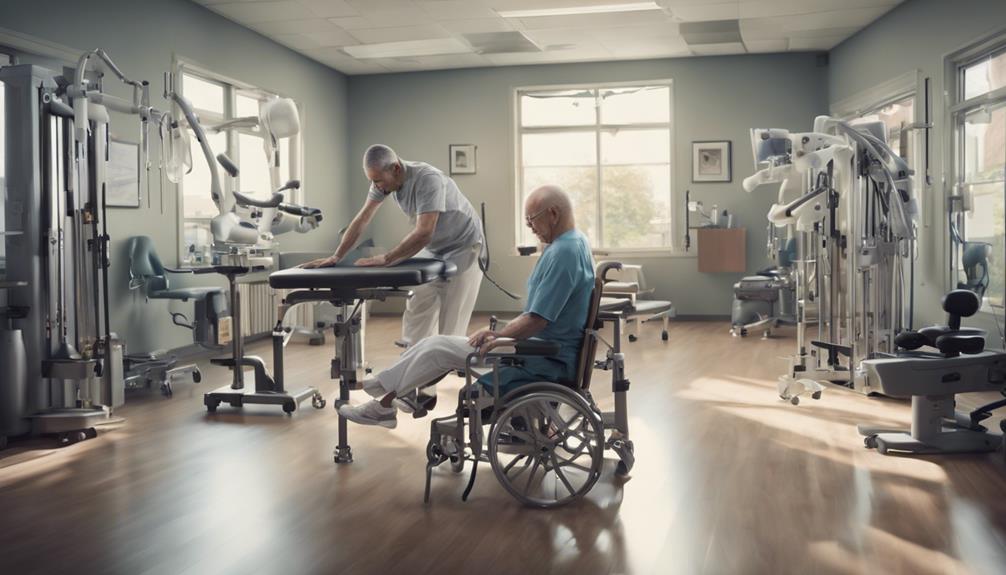Picture a complex network of nerves that stretches throughout your entire body, playing a crucial role in sending messages and controlling movement. Now, consider the consequences of a spinal cord stroke on this intricate system.
The journey of spinal cord stroke recovery is a complex path that demands patience, perseverance, and a comprehensive approach.
As we explore the nuances of this process, we uncover the remarkable resilience of the human body and the evolving strategies that pave the way towards restoration.
Key Takeaways
- Neuroplasticity crucial for rewiring neural pathways.
- Individualized rehab programs optimize recovery outcomes.
- Early intervention maximizes recovery potential.
- Lifestyle changes aid prevention and recovery.
Understanding Spinal Stroke Rehabilitation
Spinal stroke rehabilitation entails a comprehensive approach aimed at restoring motor function and sensory capabilities through targeted therapies and neuroplasticity mechanisms. Physical therapy plays a vital role in this process by focusing on improving strength, range of motion, and mobility post-spinal stroke. Through tailored exercises and techniques, physical therapists help individuals regain movement and enhance their overall physical function.
Occupational therapy is another essential component of spinal stroke rehabilitation, as it assists in regaining functional independence and adapting to daily activities with altered abilities. Occupational therapists work on enhancing skills necessary for independent living, such as self-care tasks and household chores. Additionally, sensory retraining is crucial for repairing the sensorimotor system and improving sensation in affected areas. Techniques like desensitization and sensory stimulation are commonly used to enhance sensory function.
At-home therapy, including full-body rehabilitation exercises, is also integral to the recovery process. Consistent practice of prescribed exercises promotes adaptive changes in the spinal cord, facilitating improved movement and strength over time.
Recovery Strategies for Spinal Strokes

Utilizing targeted rehabilitation strategies post-spinal stroke can significantly enhance functional outcomes and quality of life for affected individuals. Consistent rehabilitation, including physical and occupational therapy, plays a crucial role in promoting recovery.
Approximately 30% of individuals can regain the ability to walk with the aid of walking devices through structured rehabilitation programs. Sensory retraining is essential for repairing the sensorimotor system and enhancing sensation in affected areas after a spinal stroke.
Lifestyle changes such as stress management and quitting smoking are vital for preventing recurrent spinal strokes and facilitating recovery. Neuroplasticity, the brain's ability to reorganize itself by forming new neural connections, is key to rewiring neural pathways post-spinal stroke.
At-home therapy, like engaging in full-body exercises such as FitMi, promotes adaptive changes in the spinal cord, aiding in recovery. Embracing these strategies can optimize recovery outcomes and improve the overall well-being of individuals post-spinal stroke.
Therapeutic Approaches for Spinal Cord Recovery
Rehabilitation programs incorporating physical therapy, occupational therapy, and sensory retraining are essential for restoring function and mobility in individuals recovering from spinal cord strokes. These therapeutic approaches are designed to promote recovery, improve outcomes, and enhance independence through targeted interventions.
- Neuroplasticity: The brain's ability to reorganize itself by forming new neural connections plays a vital role in spinal cord stroke recovery, facilitating the rewiring of neural pathways.
- Individualized Rehabilitation: Tailoring rehabilitation programs to meet the specific needs of each individual promotes optimal recovery and helps regain functional abilities and mobility.
- Early Intervention: Initiating rehabilitation early on after a spinal cord stroke is crucial for maximizing recovery potential and achieving better outcomes in terms of regaining lost functions.
- Promoting Mobility: Consistent rehabilitation efforts have shown that around 30% of individuals with spinal cord strokes can regain the ability to walk with the aid of assistive devices, highlighting the importance of persistence and dedication in the recovery process.
Challenges in Spinal Cord Stroke Rehabilitation

Facing varying recovery timelines based on the extent of spinal cord damage poses a significant challenge in the rehabilitation process for individuals recovering from spinal cord strokes. Rehabilitation after a spinal cord stroke typically involves physical therapy, occupational therapy, and sensory retraining to restore function. Emotional support plays a crucial role in helping individuals overcome the challenges of spinal cord stroke recovery and adapt to their new abilities. It is important to note that around 40-42% of individuals experience improvements in symptoms following a spinal stroke, underscoring the significance of rehabilitation efforts. Managing pressure sores, which are common due to reduced sensation in certain body parts, is a critical aspect of spinal cord stroke recovery.
| Challenges in Spinal Cord Stroke Rehabilitation |
|---|
| Varying recovery timelines based on spinal cord damage |
| Physical therapy, occupational therapy, sensory retraining |
| Importance of emotional support |
| Improvement in symptoms post-spinal stroke |
Effective sensation management is key in preventing complications related to pressure sores and ensuring the overall well-being of individuals undergoing spinal cord stroke rehabilitation.
Promoting Recovery After Spinal Strokes
Consistent engagement in post-spinal stroke rehabilitation programs can significantly enhance the likelihood of individuals regaining mobility with the assistance of walking devices. To promote recovery after spinal strokes, it's essential to focus on various aspects of rehabilitation that target different areas of improvement.
Here are key strategies for promoting recovery after spinal strokes:
- Physical Therapy: Physical therapy plays a crucial role in improving range of motion, strength, and mobility post-spinal stroke. Therapeutic exercises and activities are tailored to the individual's needs to enhance physical function.
- Occupational Therapy: Occupational therapy assists in restoring functional independence by helping individuals adapt to new abilities following a spinal stroke. It focuses on activities of daily living, adaptive techniques, and equipment training.
- Sensory Retraining: Sensory retraining helps repair the sensorimotor system and enhances sensation in affected areas after a spinal stroke. This targeted therapy aims to improve sensory perception and motor control.
- At-Home Therapy: At-home therapy, such as full-body rehabilitation exercises like FitMi, promotes adaptive changes in the spinal cord to aid in recovery after a spinal stroke. Consistent practice at home complements in-clinic therapy sessions and reinforces progress made during rehabilitation.
Frequently Asked Questions
Is Paralysis From a Spinal Stroke Permanent?
Paralysis from a spinal stroke can be permanent in some cases, contingent on the level of spinal cord damage. Recovery varies per individual, with some achieving partial or full restoration.
Early, intense rehabilitation is pivotal in enhancing mobility and function post-stroke. Neural rewiring, facilitated by neuroplasticity, aids in paralysis recovery.
Consistent rehab, lifestyle adjustments, and emotional backing significantly impact recovery and life quality for those with spinal stroke paralysis.
What Are the Odds of Recovering From a Spinal Stroke?
We find that recovery odds following a spinal stroke are influenced by various factors. Rehabilitation, treatment timing, and individual health play pivotal roles. Recovery percentages can vary, but consistent therapy enhances outcomes.
Early intervention and ongoing care are crucial. Our experience shows that progress is possible with dedication and support. Active participation, tailored interventions, and professional guidance contribute significantly to positive outcomes post-spinal stroke.
Can You Make a Full Recovery From a Spinal Stroke?
We can make a full recovery from a spinal stroke. Factors such as prompt medical intervention, effective treatment, and dedicated rehabilitation significantly impact recovery chances.
Lifestyle changes, consistent rehabilitation, and managing underlying health conditions play a crucial role in enhancing outcomes and reducing future risks.
Early diagnosis and focused care are essential for achieving optimal recovery from spinal strokes. It's possible to achieve a full recovery with the right interventions and support.
What Is the Life Expectancy of a Person With a Spinal Stroke?
We believe that the life expectancy of individuals with spinal strokes can vary significantly based on factors such as stroke severity, underlying health issues, and age. Studies suggest that those who experience spinal strokes may face higher mortality rates compared to the general population. Timely medical care, effective rehabilitation, and proper management of complications are crucial in influencing post-stroke life expectancy.
Regular follow-up, lifestyle adjustments, and treatment adherence can positively impact recovery and quality of life.
Conclusion
In conclusion, spinal cord stroke recovery requires a comprehensive approach that includes medication, therapy, and lifestyle modifications. Additionally, incorporating physical rehabilitation alongside emotional support can significantly enhance the recovery process. By utilizing effective stroke recovery techniques, patients can improve their mobility and regain independence, leading to a better quality of life post-stroke. Developing a personalized recovery plan that addresses individual needs is essential for achieving optimal outcomes.
One interesting statistic is that studies have shown that up to 90% of patients who undergo intensive rehabilitation after a spinal stroke experience significant improvements in motor function and quality of life.
This highlights the importance of early intervention and dedicated rehabilitation programs in maximizing recovery outcomes for individuals affected by spinal cord strokes.









